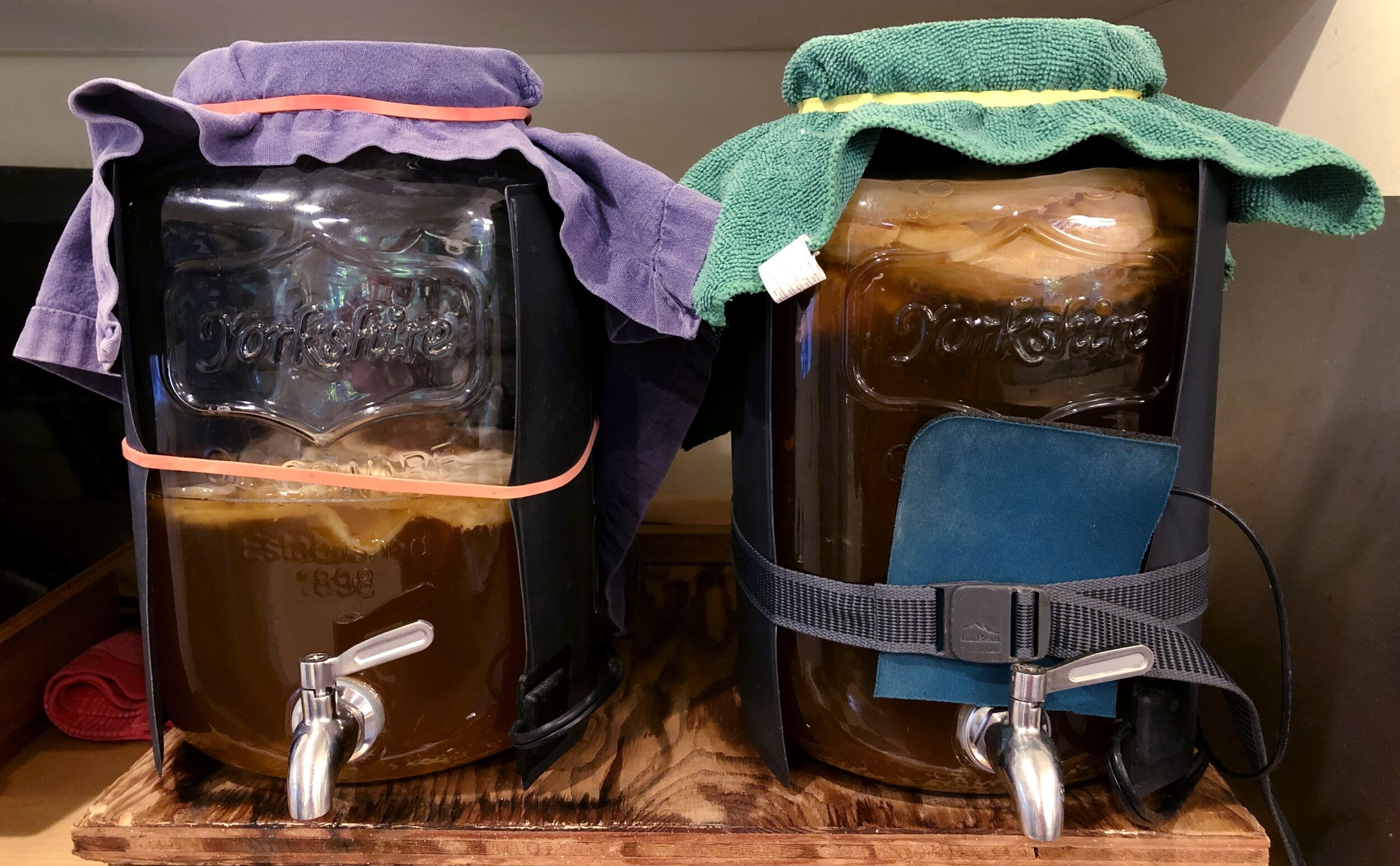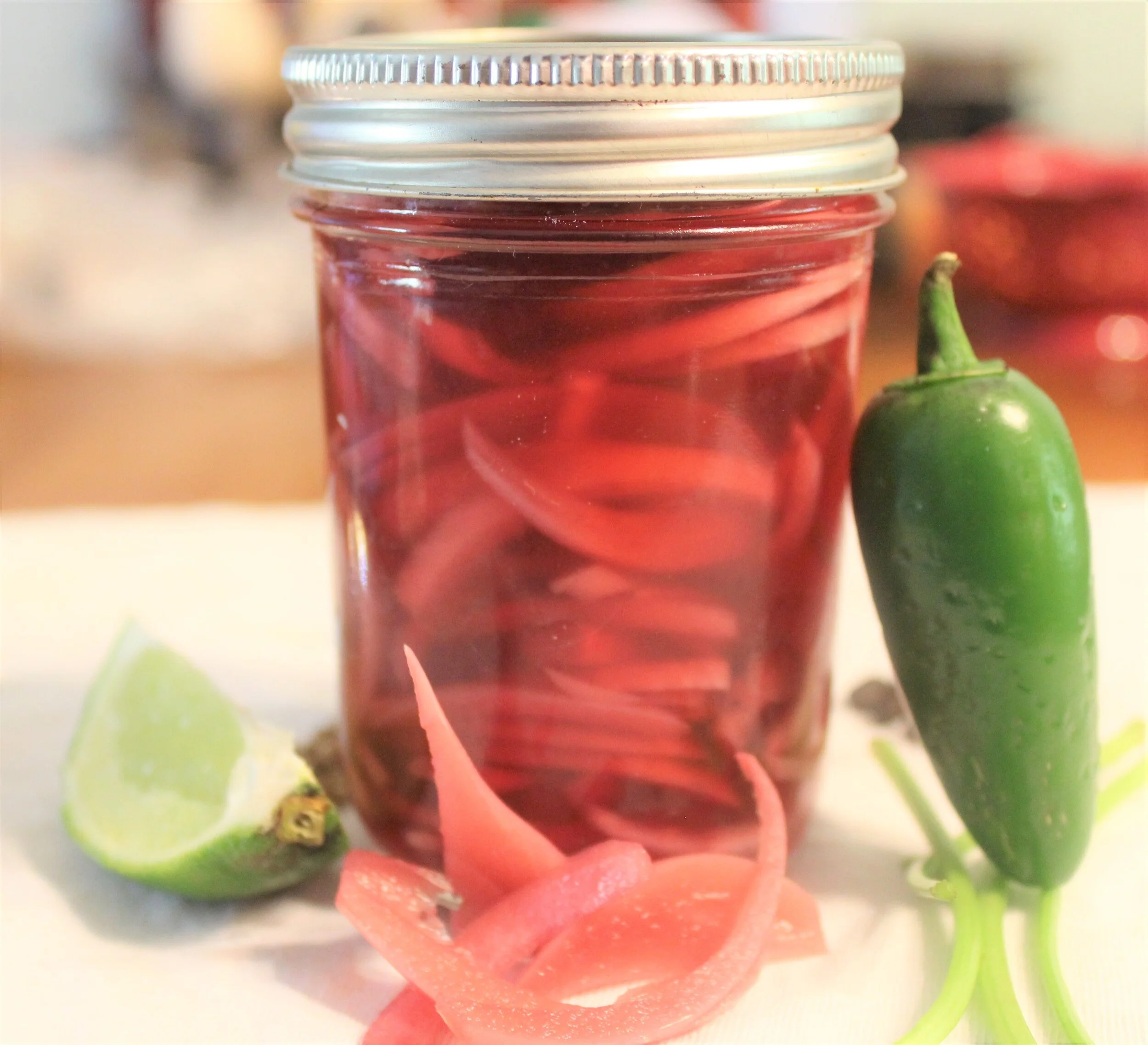Kombucha
I learned to brew kombucha from my dad, who started making it recently. This is his recipe, fine-tuned over several years of research and practice.
Kombucha is a fermented tea with a symbiotic culture of bacteria and yeast (SCOBY). Like other fermented foods, it contains living cultures that promote a healthy gut microbiome -- the trillions of species living inside your intestines. There is increasing scientific evidence around the benefits of fermentation. Eating fermented foods increases the diversity of the gut microbiome.
Making kombucha is easy because the SCOBY does all the hard work for you. The process includes two fermentation steps. First, place the SCOBY in a sweet tea mixture and leave it to ferment for one to three weeks. Then, bottle and store it at room temperature to continue the fermentation process, and encourage carbonation. Finally, refrigerate it to maintain a relatively stable level of carbonation – otherwise pressure will continue to build up in the bottle.
Read about the process in more detail here.
You’ll need:
Brewing:
SCOBY (order one online, get a chunk from a friend)
2-gallon vessel or jar
1 gallon of spring water or filtered tap water: If you don’t have a spring, you can filter tap water or cover it with a cloth and let it sit overnight so that the chlorine evaporates.
Evaporated cane sugar
A mixture of 6 black and green tea bags (go for organic and fair trade if you can)
White vinegar
pH test strips
Bottling
1 packet (5 g) champagne yeast (ideally from a reputable, local brewing store)
A pinch of sugar
8 clean 16-oz bottles with tight-fitting lids. Flip tops work better than screw-on; it needs a very tight seal to build enough pressure to carbonate.
A funnel
Juice or pieces of fruit. This is optional. How much fruit, and what flavor is up to you, but I recommend starting with a classic, like ginger.
FERMENTATION: PART ONE
Brewing kombucha from scratch
Brew strong, sweet tea with about 2 cups of the filtered water: add 4 black tea bags, let it cool for a moment and then add 2 green tea bags (green tea will turn bitter if put in boiling water). This is not a strict ratio; adjust to come up with the flavor you prefer). Let it steep for about 5 minutes.
Add 1 cup (200 g) of evaporated cane sugar. The yeast will eat the sugar.
Toss your tea bags. (And compost them.)
Mix the tea into the rest of the spring water, so you end up with 1 gallon of weak tea.
Add the SCOBY. The SCOBY is a disk of bacteria covered in filaments of brown yeast. If you’ve ordered it online, it will come in a sealed container with enough juice to feed it. Pour all the contents of the container into the gallon of tea. Now you have one gallon of very weak kombucha.
Pour into the fermentation container. Transfer the mixture into your preferred fermentation vessel with a spout, or dispenser, for easy tasting and bottling. A new SCOBY will form on top of the tea and grow to the edges of the vessel so it forms a film over the top.
Cover the vessel with a cloth to keep fruit flies, bugs, and dust from getting in. Make sure oxygen can get through.
Add a splash of distilled white vinegar to keep mold from developing. If mold forms, discard the brew and SCOBY and start fresh.
Let it sit. It will take one to three weeks (depending on temperature and karma) to achieve the perfect flavor and acidity. The ideal temperature is 75˚ - 85˚ F.
Keep tasting it every day. Within 1-3 weeks the sugar will mostly be gone, and the kombucha will be tart and lightly sweet. It is ready when you like the taste. Or you can test the acidity using pH strips. The ideal pH is between 2.5 and 3.5.
FERMENTATION: PART TWO
After 1-3 weeks of fermentation, once it tastes right and the pH is between 2.5 and 3.5, it’s time to bottle your kombucha!
Bottling is fun because you can use any juice you want to flavor it. You can buy or make your own, add chunks of fruit, herbs, vegetables, even flowers – it’s a creative choice. You can also drink it plain. In my experience using chunks or blended fruit creates a mushy build-up, so I prefer juice. My favorites include pear, mango, and ginger.
The sugar from the juice will feed the SCOBY, which will continue to ferment after bottling.
Bottling
Activate the yeast: Mix the yeast with a few teaspoons of warm water and a pinch of sugar. The sugar activates it. This does not need to be a precise process. Making it into a slurry makes it easy to mix in. Yeast isn’t necessary, but it does guarantee your kombucha will fizz nicely.
Bottle: Pour kombucha from the big fermentation vessel into a jug or smaller container, and mix in the yeast slurry thoroughly. Put the bottles in the sink (in case of splashing) and funnel equal amounts of kombucha into each container, how much?
If you want to flavor it, fill the rest of each bottle with juice, leaving an inch or two of space at the top. As the brew continues to ferment, pressure will rise inside the bottle, and it could overflow or explode if too full.
Burp: Every day you should “burp” the bottles, opening them slightly to check the level of carbonation. And carefully! It could hit the ceiling if you wait too long.
Wait: It takes about one to three days for kombucha to finish fermenting.
Refrigerate: When it’s ready, put the bottles in the fridge to stop the fermentation process. It can last one to three months in the fridge.
Keep the process going continuously by brewing a new gallon of tea each time you bottle, and taste the brew every day. The SCOBY does best with continuous nourishment, new tea and sugar every week or so, but it can last several months without. Just resume nourishment as soon as you can.
To share the SCOBY with a friend, peel off a layer (they grow in layered disks on top of each other) and store it in a sugar-and-tea medium in a glass or ceramic vessel. You can start infinite new brews this way.
Recommended Pairings











